Human Flower Project
Sunday, July 22, 2007
Get Around: Garden Panoramas
This garden project by an international band of geo-photographers will knock your socks off and turn your head all the way around.
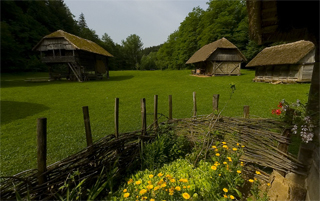
19th Century Garden, Dolenjska, Slovenia
Boštjan Burger
Via: World Wide Panorama
A garden is a 360-degree experience, hard to capture in a still photograph. Close-ups are too short and buggy, wide angles too distant and angelic. And we miss what’s going on above, below, behind the camera.
Rubbernecks and inquiring eyes will be twistfully delighted by Gardens, a collection of interactive panoramas all taken between June 20-25, 2006. Here from Damascus, Syria, Gloucester, Massachusetts, to Himi City, Japan, are scores of gardens—garden visits, really—since, as we move the virtual “eye” across the screen, we are turning around in each environment. You can look down a path in Bodoe, Norway or over a field of pink wildflowers to the Spanish Coast at Coruna, or behind you at a group of hikers in flowerless Queens Garden, Utah.
Photographer and geographer G. Donald Bain at the University of California Berkeley founded the World Wide Panorama project with Landis Bennett. Here on the web, 360-degree photographers from around the world come together four times a year (at the equinoxes and solstices) to document a different theme. In advance of last year’s summer solstice, Don sent out a probing invitation to Gardens. He’s graciously permitted us to excerpt his letter:
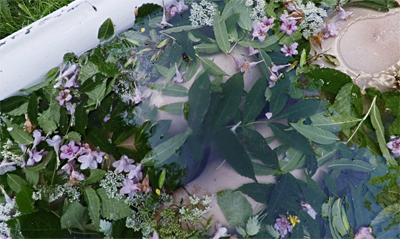
A Garden of Delight, Kammeny Privoz, Czech Republic
Jeffrey Martin, Prague
Via: World Wide Panorama
“Nobody need travel very far to find an interesting subject, or interpret the theme as a metaphor. Just look around, think about what makes gardens in your particular place special and distinctive, then find a good example with photographic possibilities.
“Gardens range from prim little front yards, just lawn and flowerbeds, to elaborate landscapes with plants originating from all over the world, or for that matter fruits and vegetables. Some gardens are small and private, others open to the public and world famous.
“One way of looking at gardens is that they embody our ideals for a vegetated space – filtered by cultural context and physical environment. What makes a garden in Arizona different from one in Connecticut, Hawaii, Italy, Mexico, Alaska, Japan, or Brazil? Each will have distinctive aspects that set it apart from the others….
“Given our ability to alter the environment, even more important than physical factors are our expectations and desires. What do we want from a garden – organic vegetables, brilliant flowers, species native to the region, unusual plants from all over, shade from the sun, shelter from the wind, impressive vistas or intimate spaces? How do we want to manage it – manicured, casual, or wild?
“Each culture evolves its own aesthetic of landscaping. Some are widely understood and emulated – everyone recognizes a classic Japanese garden, for example. But most gardens are subtle variations on a cultural/environmental theme, modulated by local circumstances and individual preferences, and sometimes by institutional mandates.
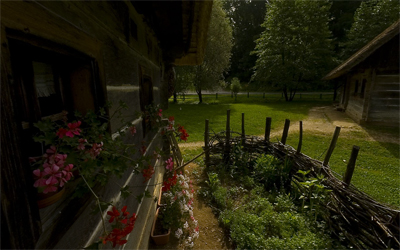
19th Century Garden, Dolenjska, Slovenia
Boštjan Burger
Via: World Wide Panorama
“Every major city has one or more famous gardens, often city parks. London has the Chelsea Physic Garden, established in 1673 to collect and study medicinal plants. San Francisco has the Japanese Tea Garden, a by-product of the 1915 Panama-Pacific Exposition. Kyoto is famous for its temples, including the unique raked gravel Zen gardens. The Missouri Botanical Garden in Saint Louis is a world leader in botanical research as well as a public park. Banyan Park in Lahaina on the Hawaiian island of Maui is covered by a single huge banyan tree.
“Vegetable and fruit gardens reflect culture and environment. In what environments would you expect the following to be grown: olives, apples, papayas, avocadoes? Tomatoes, rhubarb, vegetable marrow, okra, tomatilloes?
“Botanical gardens serve two purposes, research and public education. Some display the vegetation of the world, others focus on the local area. They are usually laid out geographically and all the plants should be labeled. Some contain unusual or unique plants, such as the Victoria lily at Kew Gardens near London, or Captain Bligh’s breadfruit on the West Indian island of Saint Vincent….
“So, take a good look around you, try to interpret the physical and cultural reasons for what you see planted, where and why. Choose a garden, large or small, private or public, flowers or vegetables or lawns. Find a way to bring out its special beauty and interest in your panoramic photography. Learn all about it and write a good caption. Easy!
.(JavaScript must be enabled to view this email address)
Don Bain
Geographer at Berkeley”
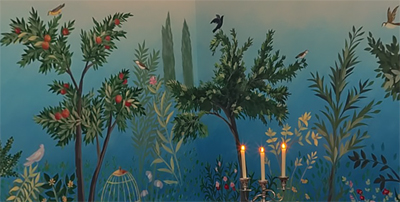
Livia’s Garden, near Front Royal, Virginia, USA
Rose Hughes Steuart’s reproduction of a Roman fresco
at Poplar Forest, a recreation of Thomas Jefferson’s home
Skip Steuart
Via: World Wide Panorama
Scan through thumbnails of all the panoramas or look for gardens by region and nation. This is surely the most amazing human flower project we’ve encountered in months. We especially enjoy how some photographers have dwelled on the human—for example, Rodolpho Pajuaba in his Garden of Ronaldos from Brazil—while others focused on flora or fauna, (feline, in this case). Many of the gardens are grand and famous, others humble.
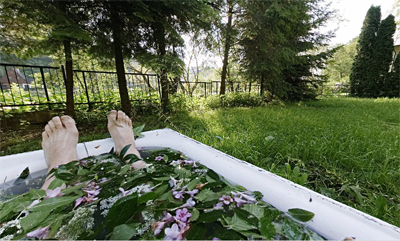
A Garden of Delight, Kammeny Privoz, Czech Republic
Jeffrey Martin, Prague
Via: World Wide Panorama
We hope that readers will get around this thrilling site and let us know your favorites. And we thank Don Bain and these three marvelous photographers for permitting us to share their work here. One final note and question, while looking at these panoramas, we have had the distinct sense of visiting each garden WITH someone. Is it this 360-degree format that turns photography—normally a private and contemplative experience—into something that feels sociable?




